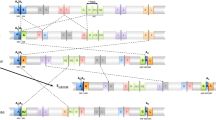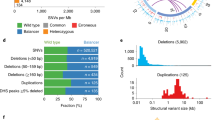Abstract
THE variegated position effect is associated with chromosomal rearrangements involving heterochromatin (reviewed in ref. 1). In Drosophila melanogaster, cytological studies of the salivary gland chromosomes of strains carrying such rearrangements show that in some cells, the chromosome regions adjacent to broken heterochromatin lose their characteristic arteristic banded appearance and become heterochromatised. The extent of this morphological change varies from cell to cell, but it has been noted that heterochromatisation seems to terminate preferentially just short of relatively large deeply staining bands2,3. This observation might be due to the fact that such bands are more readily visible, and hence more likely to be scored as euchromatin than smaller bands. The involvement of other factors is however suggested by the observation3 that heterochromatisation associated with a given inversion in two genetic backgrounds terminates with different frequencies adjacent to certain bands which were morphologically similar in the two strains. A factor which, it has been suggested4, may affect the progress of heterochromatisation is a prior change in the nucleic acid content of affected regions. Early measurements of nucleic acid content using ultraviolet photographic microdensitometry of whole bands4 or spot estimations of optical density5 yielded equivocal results. We decided to use scanning microdensitometry to investigate the possibility that the differences in extent of heterochromatisation observed in our strains might be related to the DNA content of the bands concerned.
This is a preview of subscription content, access via your institution
Access options
Subscribe to this journal
Receive 51 print issues and online access
$199.00 per year
only $3.90 per issue
Buy this article
- Purchase on Springer Link
- Instant access to full article PDF
Prices may be subject to local taxes which are calculated during checkout
Similar content being viewed by others
References
Baker, W. K., Adv. Genet., 14, 133 (1968).
Hartmann-Goldstein, I. J., Genet. Res., 10, 143 (1967).
Wargent, J. M., thesis, Univ. Sheffield (1972).
Caspersson, T., and Schultz, J., Nature, 142, 294 (1938).
Cole, P. A., and Sutton, E., Cold Spring Harb. Symp. quant. Biol., 9, 66 (1941).
Bridges, C. B., J. Hered., 26, 60 (1935).
Author information
Authors and Affiliations
Rights and permissions
About this article
Cite this article
WARGENT, J., HARTMANN-GOLDSTEIN, I. & GOLDSTEIN, D. Relationship between DNA content of polytene chromosome bands and heterochromatisation in Drosophila. Nature 248, 55–57 (1974). https://doi.org/10.1038/248055b0
Published:
Issue Date:
DOI: https://doi.org/10.1038/248055b0
This article is cited by
-
Cytogenetic and molecular aspects of position effect variegation in Drosophila melanogaster
Chromosoma (1991)
-
Cytogenetic and molecular aspects of position effect variegation in Drosophila melanogaster
Chromosoma (1986)
-
Contrasting response of euchromatin and heterochromatin to translocation in polytene chromosomes of Drosophila melanogaster
Chromosoma (1980)
-
Cytological observations on the interaction between two inversions responsible for position-effect variegation in Drosophila melanogaster
Chromosoma (1975)
Comments
By submitting a comment you agree to abide by our Terms and Community Guidelines. If you find something abusive or that does not comply with our terms or guidelines please flag it as inappropriate.



